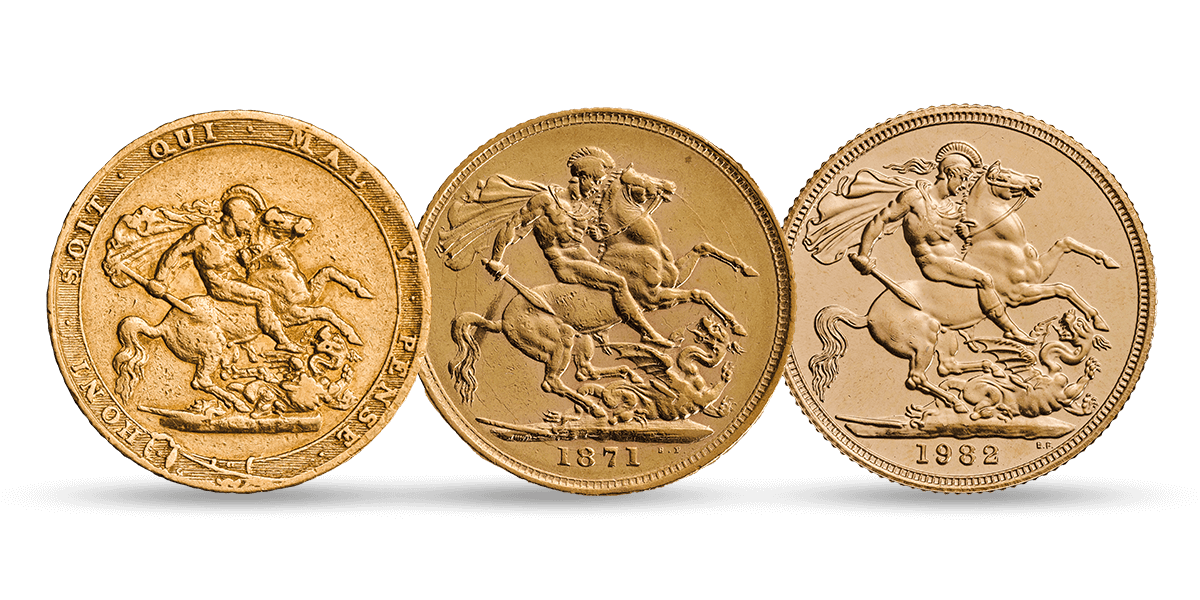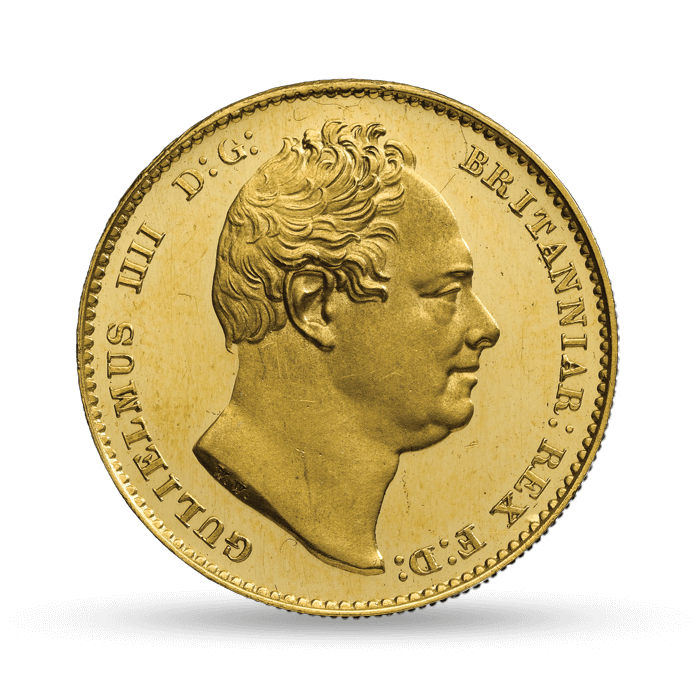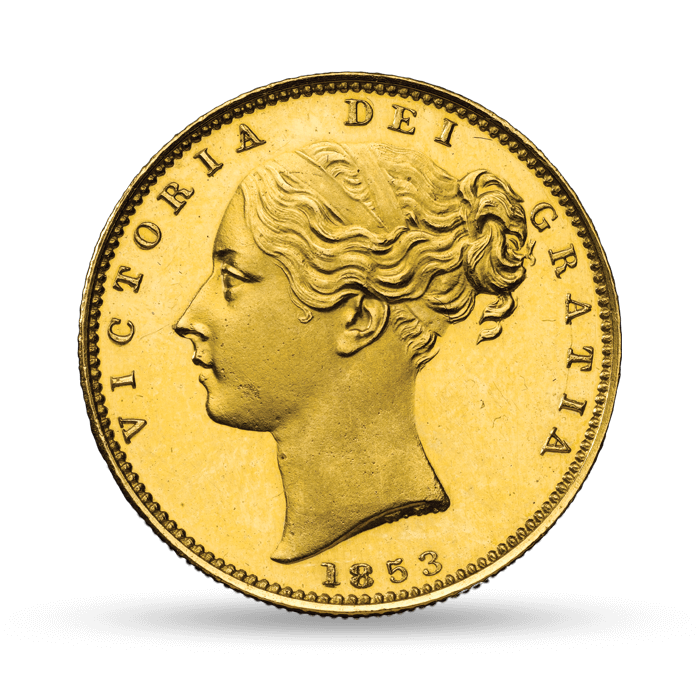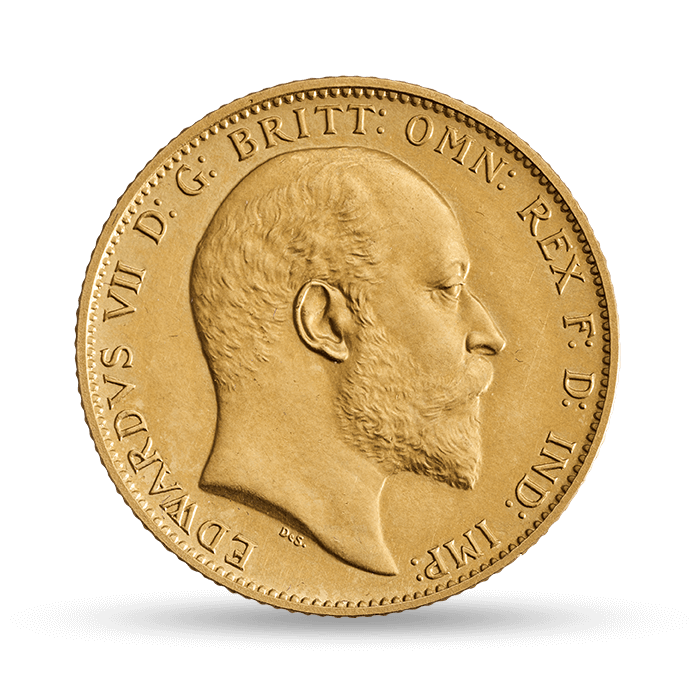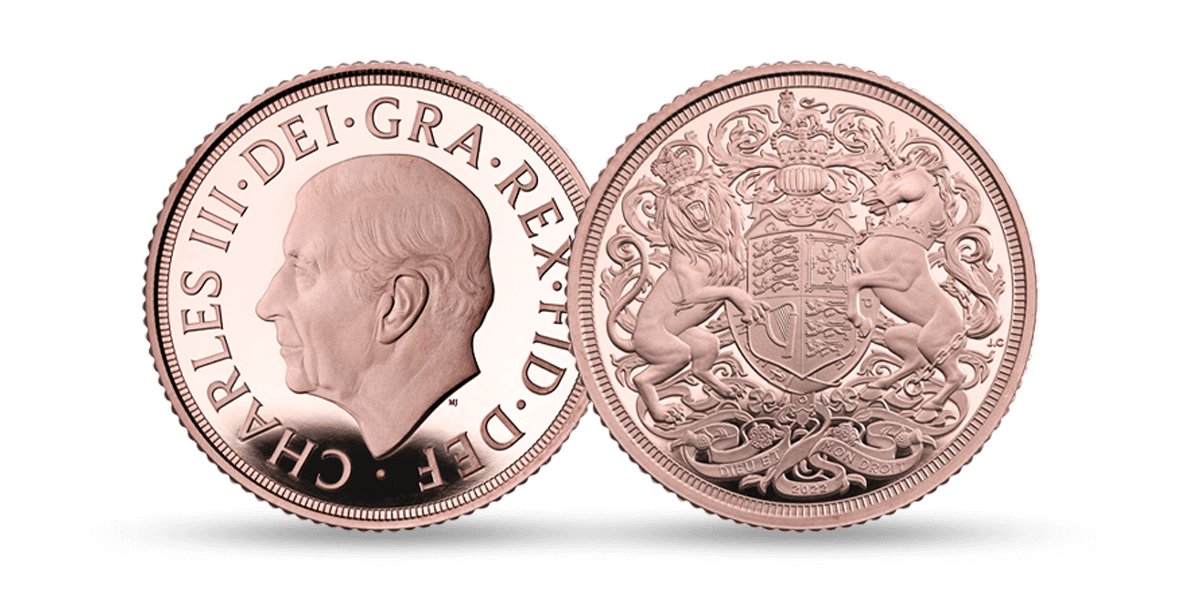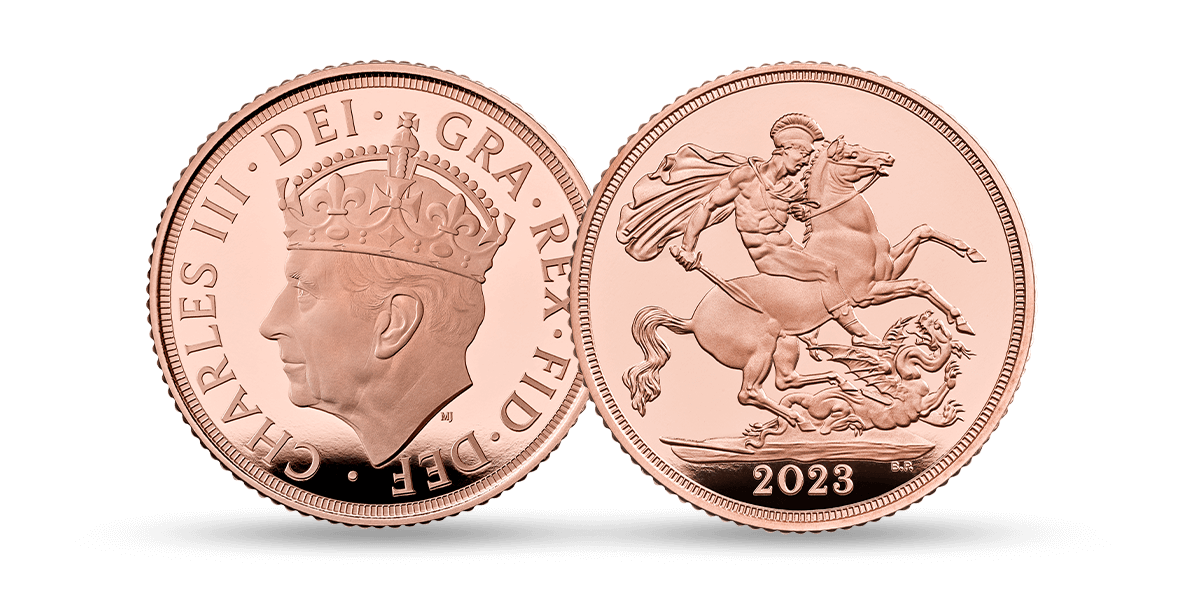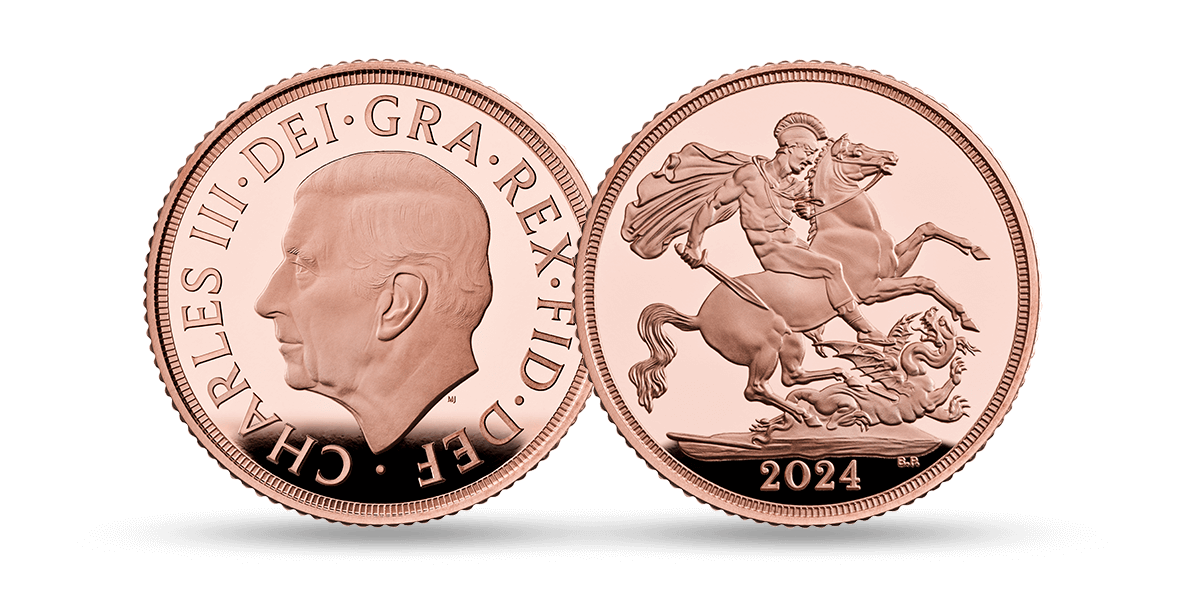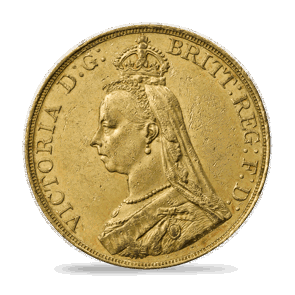With an impressive history dating back to 1489, The Sovereign has become known as the ‘chief coin of the world’ because of its accuracy and reliability.
The issue of a monarch’s first Sovereign is always a significant moment, looking ahead at the start of their reign. Pistrucci’s St George and the dragon appears on the Sovereigns released in celebration of His Majesty King Charles III’s coronation, but these coins feature a crowned coinage portrait of the monarch instead of the first definitive coinage portrait of His Majesty The King. The Sovereign Collection 2024 features the first Proof Sovereigns to display both Pistrucci’s classic design and the first definitive coinage portrait of King Charles III.
The Sovereign was revived in 1817 during the reign of George III, and the famous St George and the dragon design by Benedetto Pistrucci featured on the reverse of the coin, which many refer to as the modern Sovereign. In 1821, it was remodelled to remove the old French inscription around the edge so a larger surface area could display Pistrucci’s design. The design remained on The Sovereign until it was retired in 1825 and replaced with a design depicting the Royal Arms.
Several decades later, in 1871, the classic design appeared on The Sovereign during the reign of Queen Victoria and has appeared on Sovereigns struck for every British monarch since. Only replaced on rare occasions since its reinstatement, often to celebrate historic moments, Pistrucci’s beautiful design has undoubtedly become a modern classic.
George III
The Sovereign as we know it was introduced during the reign of George III. The guinea had been the prevalent gold coin in circulation until this time, but its awkward 21-shilling value gave rise to calls for a coin with a more convenient value of 20 shillings. The Master of the Mint at the time – William Wellesley Pole – reintroduced The Sovereign and commissioned Benedetto Pistrucci to create the coin’s reverse design.
George IV
The first Sovereigns featuring the portrait of George IV were issued in 1821 after the death of his father, George III, in 1820. The first coinage portrait of George IV depicted a laureate portrait designed by Benedetto Pistrucci.
The monarch wasn’t impressed with the fuller features of Pistrucci’s neoclassical design and demanded that a new coinage portrait be created based on a more flattering portrayal from a bust of the king by Sir Francis Chantrey. The Italian engraver refused to copy the work of another artist and his coinage portrait was replaced by the work of his rival, William Wyon, who complied with the king’s wishes.
The St George and the dragon design was also altered for the 1821 Sovereign. The old French inscription was removed, the broken lance held by the saint replaced with a sword and the date was added below the design. Sadly, this beautiful reverse design was replaced in 1825.
William IV
When George IV died without a legitimate heir, the line of succession passed to his brother, William IV, with Sovereigns bearing his portrait being dated from 1830. Similar to the later Sovereigns of George IV’s reign, those struck during the reign of William IV featured a design of the Royal Arms on the reverse instead of the St George and the dragon design.
Queen Victoria
Queen Victoria acceded to the throne in 1837. The Shield design that had appeared on The Sovereign since the reign of George IV had to be altered at the start of Queen Victoria’s reign to remove the Hanoverian Arms, as the line of succession for the Kingdom of Hanover was limited to the male line.
Although the Royal Arms design had appeared on The Sovereign since the reign of George IV, Pistrucci’s St George and the dragon design was reinstated in 1871. The Deputy Master of the Mint at the time, Sir Charles Fremantle, made the decision to revive Pistrucci’s famous design to improve the appearance of The Sovereign. During the reign of Queen Victoria, Sovereigns struck in the UK featured three different coinage portraits of the monarch. The first was the beautiful Young Head designed by William Wyon. This remained on the coins of Queen Victoria for nearly 50 years until the Jubilee Head by Joseph Edgar Boehm replaced it in 1887. Released during the year of Queen Victoria’s Golden Jubilee, the design wasn’t well received at the time because of the small crown on the queen’s head. In 1893, Sir Thomas Brock’s Old Head design replaced the Jubilee Head.
Edward VII
After acceding to the throne in 1901, Sovereigns bearing Edward VII’s portrait were issued from 1902. The reverse of each Sovereign struck for the king featured Pistrucci’s classic St George and the dragon design.
George V
George V Sovereigns were first issued in 1911. Pistrucci’s St George and the dragon design was chosen to remain on the reverse of the coin, whilst the Australian sculptor Bertram Mackennal designed his coinage portrait. Due to the impact of the First World War, in 1917, production of The Sovereign ceased at The Royal Mint’s headquarters in London.
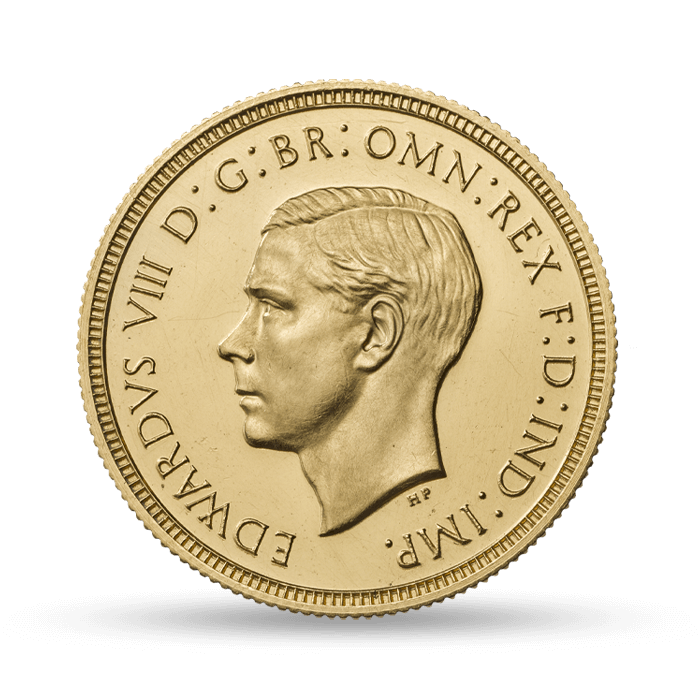
Edward VIII
Among the rarest Sovereigns are those from Edward VIII’s reign. After acceding to the throne in January 1936, Edward VIII abdicated later that same year to marry Wallis Simpson. As a result, coins bearing his portrait never entered circulation. However, The Royal Mint did produce pattern coins in extremely limited numbers, including a 1937 Sovereign.
The obverse of this Sovereign broke with tradition too, as monarchs’ portraits ordinarily faced the opposite direction to their predecessor. It can’t be said for certain why this tradition was instigated, but it dates back to the reign of Charles II. Edward VIII was insistent that his left side was his best side, so Humphrey Paget designed his coinage portrait accordingly.
George VI
George VI Sovereigns were first issued in 1937, but only a limited number of specimen coins were struck that year to commemorate the monarch’s coronation. Pistrucci’s St George and the dragon design features on the reverse of the coin, whilst a coinage portrait of the new king, also designed by Humphrey Paget, appears on the obverse of the coin.
Queen Elizabeth II
Although Queen Elizabeth II acceded to the throne in 1952, the first Proof Sovereign of her reign wasn’t struck until 1953. The St George and the dragon design was chosen for the reverse, whilst a laureate portrait of Queen Elizabeth II, designed by Mary Gillick, appears on the obverse of the coin.
During her reign, Queen Elizabeth II had five definitive coinage portraits. The Mary Gillick portrait remained on circulating coins until decimalisation in 1971 and on Maundy money until the end of her reign. Arnold Machin designed the second definitive coinage portrait of the monarch, which appeared on coins produced in 1968 ready for decimalisation and all decimal coins produced for circulation until 1984.
Designed by Raphael Maklouf, Queen Elizabeth II’s third definitive coinage portrait appeared on coins between 1984 and 1998; the fourth coinage portrait by Ian Rank-Broadley appeared on coins between 1998 and 2015. Coins struck from 2015 until her passing in 2022 feature the monarch’s fifth and final definitive coinage portrait, designed by Jody Clark, which marked the first time in more than 100 years that a designer from The Royal Mint had designed a definitive coinage portrait.
The reverse design of The Sovereign changed several times during the reign of Queen Elizabeth II. In 1989, special obverse and reverse designs marked the 500th anniversary of The Sovereign, both designed by Bernard Sindall. The obverse design is an enthroned portrait of Queen Elizabeth II, whilst the reverse design features the Royal Arms at the centre of a crowned Tudor rose.
To celebrate Queen Elizabeth II’s Golden Jubilee in 2002, the St George and the dragon design was replaced by the Royal Arms, designed by Timothy Noad. In 2005, a modern interpretation of St George and the dragon, also by Timothy Noad, replaced Pistrucci’s classic design for one year only. To celebrate Queen Elizabeth II’s Diamond Jubilee in 2012, another modern interpretation of St George and the dragon, this time designed by Paul Day, replaced the Pistrucci design.
In 2016, the obverse of The Sovereign featured a portrait by James Butler to celebrate Queen Elizabeth II’s 90th birthday. To commemorate 200 years since the modern Sovereign was introduced, the 2017 Sovereign featured the original design by Pistrucci that appeared in 1817, including the old French inscription and the lance instead of the sword.
The final Sovereign to feature a design in honour of a special occasion during the reign of Queen Elizabeth II was that created in commemoration of the monarch’s Platinum Jubilee in 2022. On this occasion, an interpretation of the Royal Coat of Arms designed by Timothy Noad replaced the classic Pistrucci design. Although Pistrucci’s St George and the dragon design has remained largely unchanged since its reintroduction during the reign of Queen Victoria, the design was re-engraved in 2009 to omit the streamer flowing from the saint’s helmet.
King Charles III
His Majesty acceded to the throne on 8 September 2022 following the passing of his mother, Queen Elizabeth II. The first Sovereign to feature a portrait of The King was the Memorial Sovereign struck to commemorate his mother’s life and legacy. The reverse of the coin features an intricate depiction of the Royal Arms designed by Jody Clark, and the obverse features the official coinage portrait of King Charles III as designed by Martin Jennings.
On 6 May 2023, His Majesty celebrated a historic milestone with his coronation. To mark the occasion, The Royal Mint released a Coronation Sovereign. This was the first of His Majesty’s Sovereigns to feature the classic Benedetto Pistrucci design of St George and the dragon. The obverse features a special crowned portrait, also designed by Martin Jennings.
After the release of the Memorial Sovereign and the Coronation Sovereign, the official coinage portrait of His Majesty, as designed by Martin Jennings, is paired with Pistrucci’s design for the first time on a Proof Sovereign. The St George and the dragon design has now appeared on Sovereigns struck for every monarch since the reign of Queen Victoria.
You may be interested

2002 Elizabeth II Proof Half-Sovereign
Proof Condition
Price: £475.00
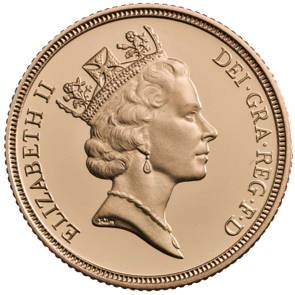
The Sovereign 1988
Proof
Price: £825.00
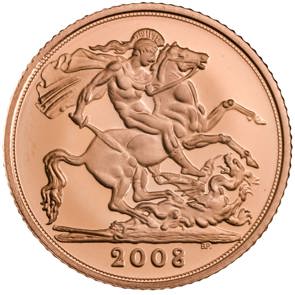
The Half-Sovereign 2008
Proof
Price: £400.00
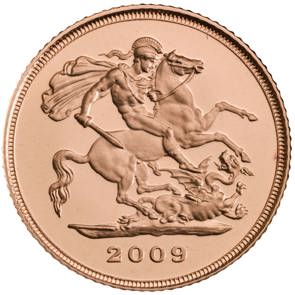
The Half-Sovereign 2009
Proof
Price: £400.00
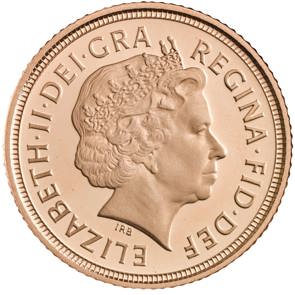
The Half-Sovereign 2011
Proof
Price: £425.00
RELATED ARTICLES
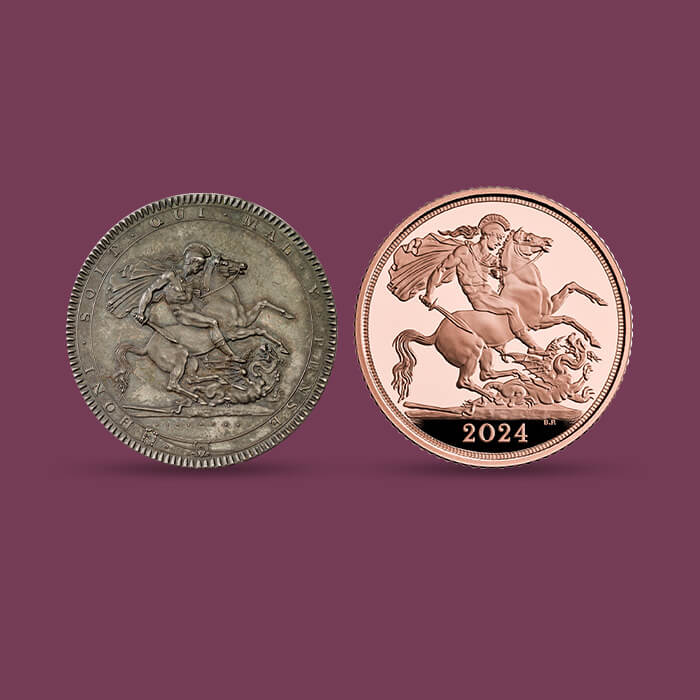
Behind a classic design
The Sovereign 'Chief coin of the world'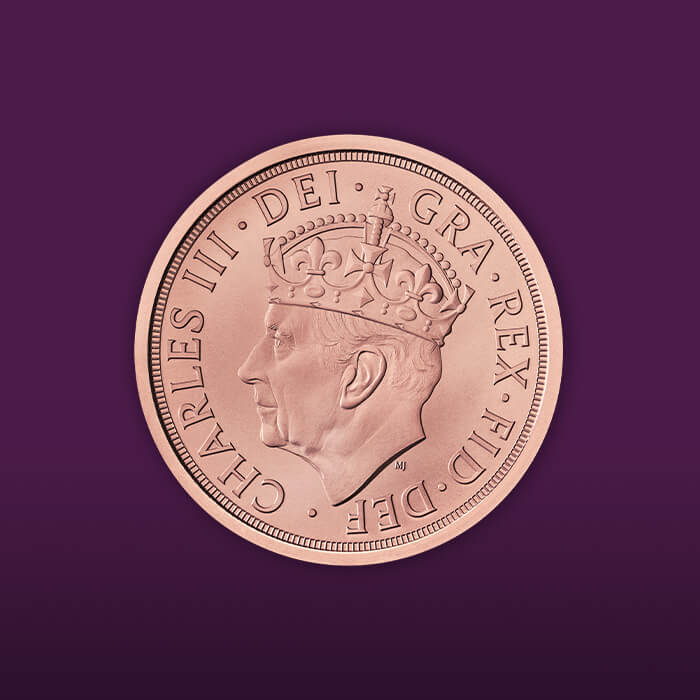
CROWNING ACHIEVEMENTS: THE SOVEREIGN AND CORONATIONS
Marking The Occasion
A SOVEREIGN FIT FOR A KING
An iconic design
